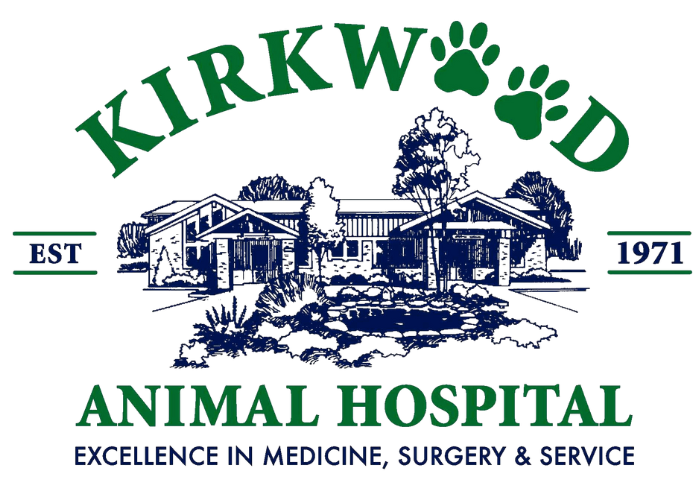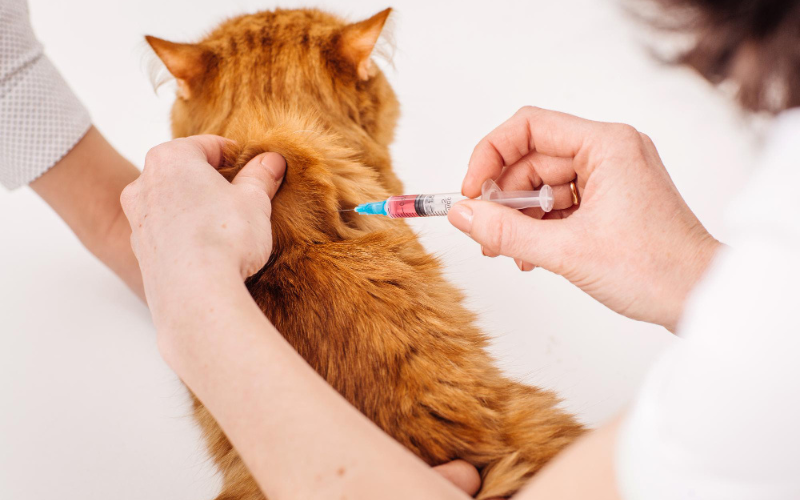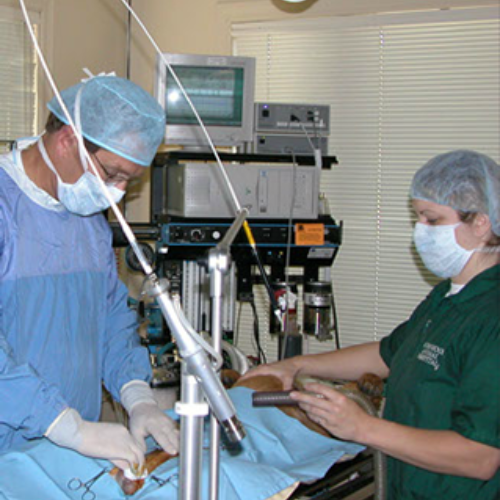Anesthesia Checklist in Kirkwood, MO
Many pet owners are terrified by the thought of their pets undergoing anesthesia. In some cases, this fear and uncertainty can prevent pets from receiving the medical care they need and deserve.
Anesthesia Checklist
What You Should Know when your pet needs Anesthesia.
The following safety procedures are included in the price of all surgeries at Kirkwood Animal Hospital as part of our commitment to excellence.
Safety precautions that Kirkwood Animal Hospital takes are:
Phase 1. Before Anesthetic: Pre-operative testing, pain control & sedation
- Pre-anesthetic blood test –A small sample of blood is taken and analyzed to evaluate the kidneys, red blood cell count, and white blood cell count. This simple safety measure checks that your pet’s organs function to ensure that they are healthy enough to metabolize the anesthesia without complications.
- ECG (EKG): To evaluate their heart.
- Physical Exam – A complete physical examination to check their vital signs (heart, lungs, and temperature), making sure they are in the best possible general health.
- IV Catheter – After completing a thorough physical examination, we place an intravenous catheter into the front leg. This catheter is placed for three reasons:
- It is easier for your pet to receive the induction anesthetic.
- Your pet will receive intravenous fluids to ensure proper tissue perfusion and prevent dehydration.
- As a precautionary measure, so we can immediately administer life-saving medication if necessary.
- Pre-anesthesia Sedation – We first administer a tranquilizer and pain relief medication that reduces anxiety and allows us to reduce the dose of general anesthesia required:
- This makes the procedure safer and less stressful, and your pet recovers smoothly from the general anesthesia.
- Animals recover from anesthesia the same way they go into anesthesia.
- Pre-Operative Pain Control:
- Administering pain drugs before the surgical procedure helps prevent “wind up”, the buildup of painful stimuli in the spinal cord.
- This also reduces the amount of post-operative drugs required and makes these drugs more effective.
Phase 2. Pre-oxygenation
- The pre-oxygenation process allows the patient to breathe 100% oxygen just before and at the completion of anesthesia, improves the safety of anesthesia, and improves recovery time.
Phase 3. Induction – with a “short-acting” general anesthetic
- This is a very critical stage where your pet is actually induced into a surgical plane of anesthesia.
- Propofol injectable anesthesia is used for both induction and short procedures.
Phase 4. Maintenance – on “short-acting” or inhalation anesthesia- and monitoring
General Anesthesia
Induction: with a short-acting general anesthetic. We only use Propofol for beginning anesthesia or for short procedures. This agent is the most expensive but also the safest agent ever used in Veterinary Medicine. It gives smooth, quick induction and rapid recovery without a hangover. For procedures longer than 10 minutes, your pet is maintained under general anesthetic with Isoflurane gas to keep them asleep. Isoflurane is a very safe anesthetic gas that allows rapid changes in the level of anesthesia.
Safety Monitors
As an additional safety precaution, we monitor your pet’s blood pressure, Carbon Dioxide (Capnography-monitoring carbon dioxide levels in the patient), heart rate, EKG, body temperature, Oxygen saturation of the blood, respiratory rate, and depth using a combination of computerized monitoring equipment.
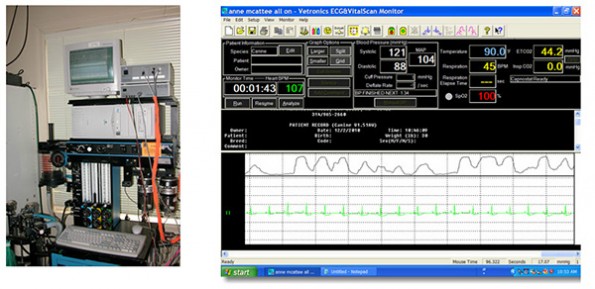
Capnography-monitoring carbon dioxide levels in the patient
- Normal air contains only 20% oxygen.
- At Kirkwood Animal Hospital, animals under anesthesia breathe 100% oxygen, which increases the amount of oxygen going to all tissues.
- Capnography is a measurement of the amount of carbon dioxide inhaled and exhaled by a patient under anesthesia.
- This measurement indicates how well a patient is breathing under anesthesia, allowing adjustments to be made to the level of anesthesia.
Warmth and Comfort
For your pet’s comfort and safety, they will be placed on a thermal barrier to help maintain their body temperature. For long procedures, we have specially designed, continuously circulating warm water blankets to keep them warm and comfortable.
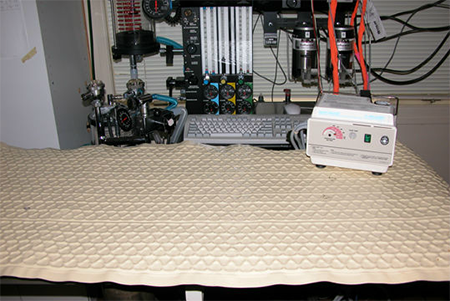
Human Monitoring
Despite having state-of-the-art computerized monitoring equipment, nothing replaces constant human observation. Besides the veterinary surgeon, there is always a veterinary assistant present to personally monitor your pet’s vital signs as well as monitor the level of anesthesia and equipment.
Phase 5. Post-Oxygenation
Post-Oxygenation – As your pet awakes, it will continue to breathe pure oxygen until the endotracheal tube is removed from their windpipe.
Phase 6. Post Anesthesia Recovery and Pain Control
Post-Operative Pain Control – Your pet will be given an injectable medication for post-operative pain control, as well as pills for at-home use. Cats tolerate very few orally administered pain control drugs. For this reason, we do not give prescriptions for cats. We do make sure they have sufficient and safe pain control while at Kirkwood Animal Hospital.
Post Anesthesia – After anesthesia, we require that your pet be fully awake before going home. All pets are slightly sedate, which helps provide a smooth and comfortable post-operative recovery. Be careful not to let the pet fall down the stairs or get into a fight with other pets. Any lethargy usually passes within 24 hours. If it does not, please call Kirkwood Animal Hospital.
Food and Water – The preoperative drugs and general anesthesia slows the digestive tract of your pet. Unless otherwise instructed, do not feed your pet more than one-third of their normal day’s intake of food and water in very small portions the night of the surgery. To do so may cause vomiting. The next day you can feed and water normally.
If you want to compare Kirkwood Animal Hospital to other Veterinary Hospitals, we provide you an Anesthesia and Surgical Check List you can print off for easy comparison.
Veterinary Services in Kirkwood, MO
Pet Laboratory Testing
Pet Ultrasound
Pet Therapeutic Laser Treatment
Pet Cryosurgery
Pet Radiology
Pet Endoscopy
Pet Advanced Medicine
Pet Urinalysis Machine
